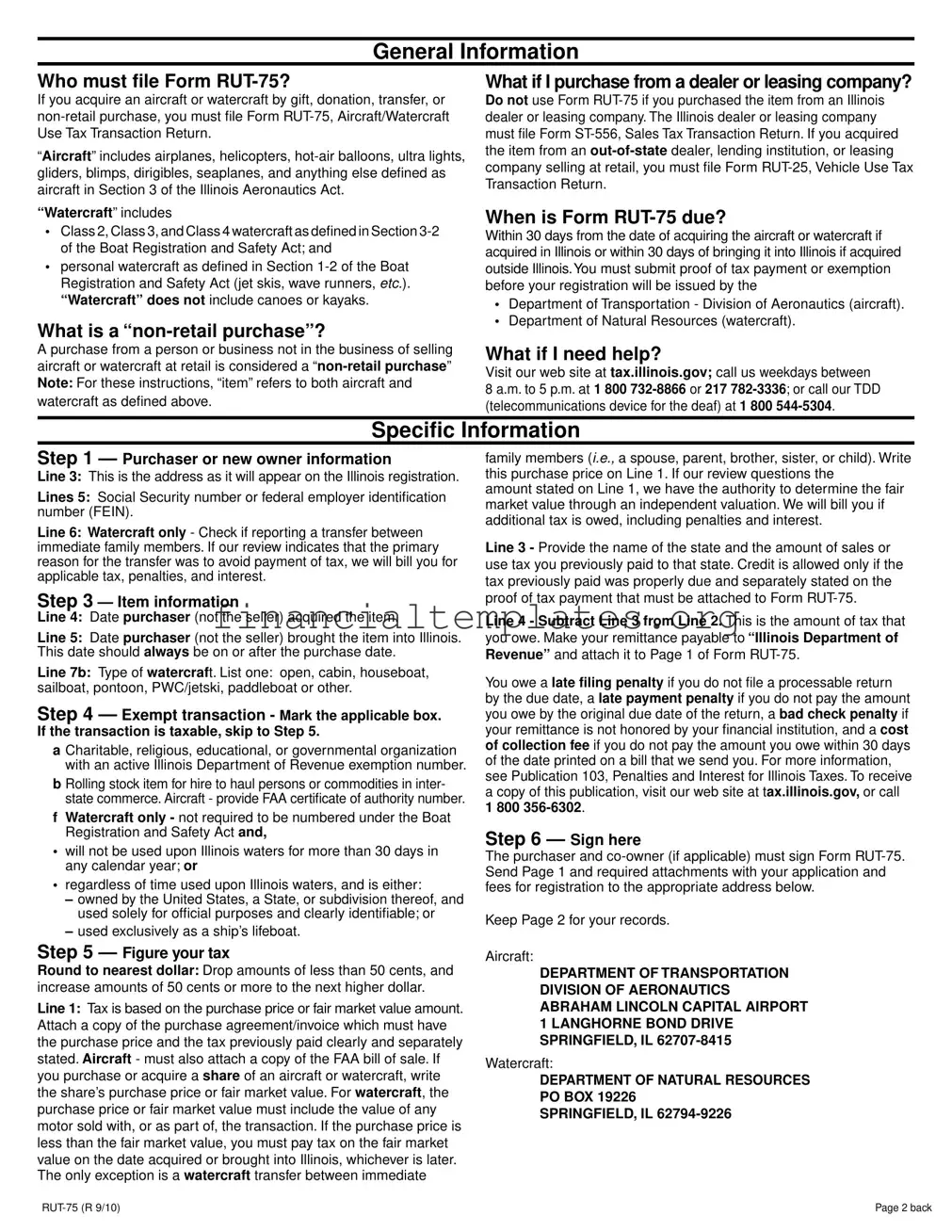The Form ST-556, Sales Tax Transaction Return, bears a resemblance to the Form RUT-75 in its primary function, which is to collect sales tax on specific transactions. Both forms are used in Illinois for reporting and paying tax but differ in the items they cover; Form ST-556 is specifically for transactions involving vehicles sold by Illinois dealers or leasing companies, contrasting with Form RUT-75's focus on private sales of aircraft and watercraft.
Form RUT-25, Vehicle Use Tax Transaction Return, is similar to Form RUT-75 as both concern the taxation of transportation assets brought into Illinois. Where RUT-75 is utilized for aircraft and watercraft acquired through non-retail sales, RUT-25 is required for vehicles purchased from out-of-state dealers. Each form ensures tax compliance for different types of property entering Illinois.
The Form RUT-50, Vehicle Use Tax Transaction Return for Private Party Vehicle Sales, also aligns closely with RUT-75, with the major difference being its application to private vehicle sales. While RUT-75 captures tax on non-retail acquisitions of aircraft and watercraft, RUT-50 does the same for vehicles purchased in private sales, ensuring that these transactions are taxed accordingly.
Another document, the Form RV-F1400301, Application for Tennessee Certificate of Title and Registration, while not an Illinois form, serves a parallel purpose for Tennessee residents, closely matching the process outlined in RUT-75 for Illinois. This form is necessary when registering a new or used vehicle, boat, or aircraft in Tennessee, highlighting the universal requirement across states to report and tax vehicle, watercraft, and aircraft acquisitions.
The Sales and Use Tax Return forms, commonly found across various states, share fundamental similarities with Form RUT-75, focusing on the declaration and payment of sales and use taxes. Though broader in scope, these forms, like RUT-75, aim to capture tax on transactions that fall outside of typical retail sales, including those involving aircraft and watercraft.
California's Form BOE-401-A2, Sales and Use Tax Return, resembles RUT-75 in its intent to collect taxes on goods purchased or transferred within its jurisdiction. Despite their geographical differences, both forms require taxpayers to report purchases of high-value items, like aircraft and watercraft, ensuring compliance with state tax laws.
New York's Form ST-121, Exempt Use Certificate, has parallels with the exempt transaction section of RUT-75, allowing for tax exemptions under specific conditions. Both documents recognize that certain transactions, including those involving aircraft and watercraft, can qualify for tax exemptions based on their use or the status of the purchaser.
The Form 8849, Claim for Refund of Excise Taxes, by the IRS, although focused on excise taxes at the federal level, shares a similar foundational purpose with RUT-75: to ensure proper tax treatment of specific types of property, including vehicles, aircraft, and watercraft. Form 8849 allows taxpayers to claim refunds on previously paid taxes, just as RUT-75 enables individuals to report and pay the correct use tax.
Lastly, Florida's Form DR-15, Sales and Use Tax Return, is akin to RUT-75 in its goal to manage the state's taxation of goods and services, including transactions involving watercraft and aircraft. This form, like RUT-75, plays a crucial role in the state's revenue system by requiring disclosure and payment of taxes due on a wide range of purchases.

